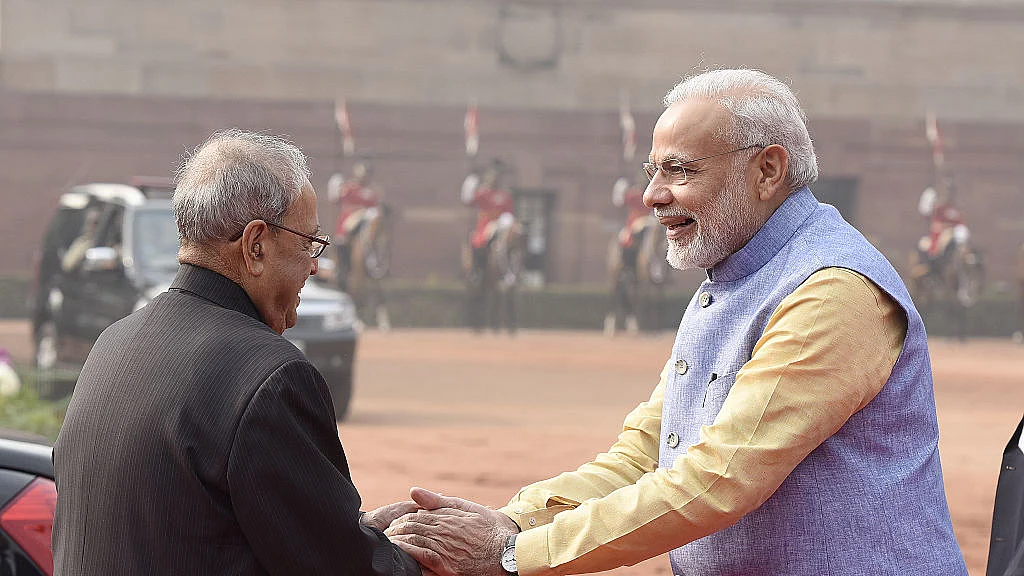Why are President, PM & Niti Aayog pushing for simultaneous polls?
The real problems are the money that political parties spend and the increasing trend of the PM and Union ministers campaigning in every state election

Niti Aayog, in a recent discussion paper, enthusiastically highlighted the arguments supporting the holding of simultaneous elections to the Lok Sabha and state assemblies. These included the supposedly high costs of staggered elections, policy paralysis brought about by the model code of conduct, disruption, and so on. The President in his addresses on the eve of Republic Day and to Parliament has lent his weight to the idea that Prime Minister Narendra Modi has taken as his mission to implement.
A lot of groundwork has already been done with a Parliamentary panel and the Election Commission of India in 2015 respectively endorsing the idea and declaring that given added resources, simultaneous elections are possible. But not everyone is convinced.
"The idea of simultaneous elections for India is based on false premises,” says Praveen Chakravarty of the think-tank IDFC Institute for one. He and several other experts point out that India had started off with simultaneous polls but abandoned it soon enough due to practical difficulties. They cite five reasons in favour of staggered polls.
Hardly a high price for democracy
While the cost of conducting polls by the Election Commission (EC) has been going up substantially, reportedly around ₹4,000 crore for the 2014 general elections, Chakravarty says that the cost of conducting all state elections would be an additional ₹4,000 crore at best.
“Now, is ₹8,000 crore every five years or ₹1,500 crore every year really that huge a cost for the world’s largest democracy which has a GDP of $1.5 trillion,” he asks with a chuckle. Just check the annual losses due to non-performing assets by our public sector banks and this amount will pale in comparison.
Former Chief Election Commissioner SY Quraishi points out that the real problem is the abnormally high amounts spent by political parties and candidates. There is no limit on how much the parties can spend and the focus ought to be on reducing the flow of black money into election campaigns.
Policy paralysis, really?
The Union Budget was presented this year and the Budget Session of the Parliament held in the middle of election campaigning in five states. There was surely enough time to take policy decisions both before and after the election, observers say. A Palanisami in Tamil Nadu or Vasundhara Raje in Rajasthan are hardly affected by the ongoing elections in the five states.
The real problem is the increasing involvement of Union Ministers in state elections. The entire union cabinet and the Prime Minister seem to be campaigning in some state or the other throughout the year. “But that is a problem of the political parties, not that of the system,” says Chakravarty.
Simultaneous elections possible only with fixed terms
In the Parliamentary system Governments are accountable to the elected legislature. If for some reason the government loses the confidence of the House, there is provision for dissolving the House, holding fresh elections and imposing President’s Rule. But simultaneous election would take away the right of electors to bring down the government and the right of the governments to recommend dissolution.
Simultaneous elections rather appear more like an alibi to stealthily bring in an uninterrupted fixed tenure of five years for the Lok Sabha and the legislative assemblies, which would mean reduced accountability.
Staggered elections ensure more accountability
Staggered polls keep the Centre and the states on their toes. The NDA Government at the Centre was on a roll since coming to power in 2014 was possibly getting a wee bit brazen, reflected in bad policy-making like the amendments brought in through The Right to Fair Compensation and Transparency in Land Acquisition, Rehabilitation And Resettlement (Amendment) Bill, 2015. Electoral reverses in Delhi and Bihar forced the Government to put the amendments on hold.
The myth of the discerning voter
An empirical study by IDFC Institute's Chakravarty found that when elections are held simultaneously to states and the Centre, 77% of the voters tended to choose the same party and didn’t differentiate between a state and a national election. Often, when there’s a gap between polls, the results turn out to be different. BJP swept all the seven Lok Sabha seats in Delhi in 2014 but managed to win only three of the 70 Assembly seats hardly eight months later.
Given a separate chance, people tend to vote differently. Why take that right away from the people? “Poor people love frequent elections. It gives them a sense of importance and also makes politicians more accountable,” says Quraishi.
Isn’t this what our democracy is all about?
Follow us on: Facebook, Twitter, Google News, Instagram
Join our official telegram channel (@nationalherald) and stay updated with the latest headlines
- Lok Sabha
- prime minister
- Narendra Modi
- Delhi
- Election Commission
- Parliament
- Bihar
- NDA Government
- 2014 Lok Sabha election
- NITI Aayog
- Model Code of Conduct
- Union Budget
- President Pranab Mukherjee
- Budget 2017
- democracy
- President’s Rule
- Chief Election Commissioner
- SY Quraishi
- Republic Day
- simultaneous elections
- Praveen Chakravarty
- IDFC Institute
- policy paralysis
